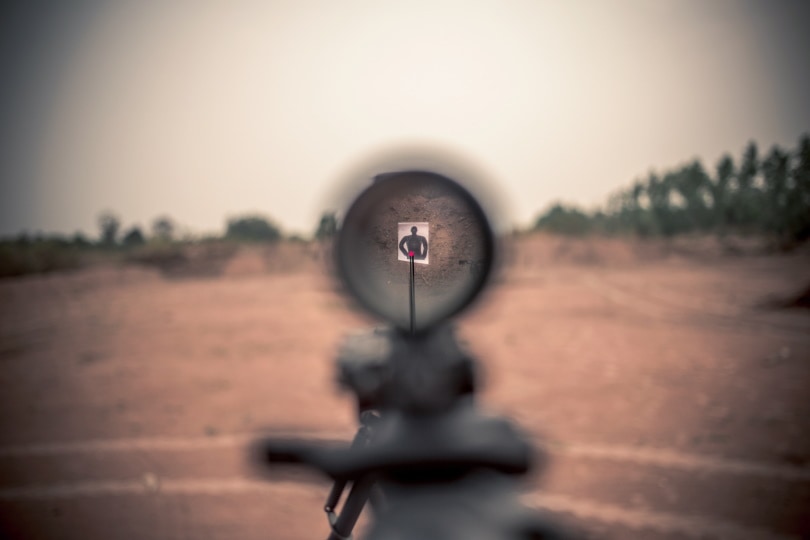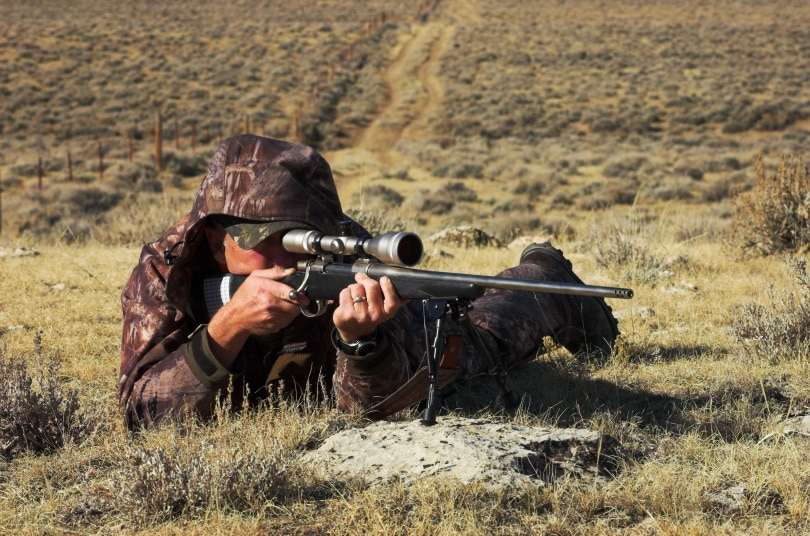How to Sight in a Rifle Scope at 50 Yards – 2025 Guide
Last Updated on

One of the most important things you need to do when you get your scope is sight it in. While most people choose to sight their scope in at 100 yards, sometimes you just don’t have the space or you plan on shooting at closer targets.
But there’s good news. While it might seem like it’s a little easier to sight your scope in at 100 yards, the truth is that it’s not more difficult at 50!
In this guide, we walk you through everything you need to know to properly sight your scope at 50 yards. This way, when you need to use your scope, you won’t have any problems hitting your target.

Before Your Start

Before you head out to the range to sight in your scope, there are a few things that you need to do. First, you need to make properly mount your scope to your weapon. Then, you need to make sure that you have all the necessary tools to make any adjustments when you get out to the range.
This varies from scope to scope, so make sure you take the time to get acquainted with yours before you head out. Finally, make sure that you’re using the same ammunition that you’ll be shooting with regularly and that you have an unused target to shoot at.
Once you have everything you need, you’re ready to head out and sight your scope!
Why You Need to Sight Your Scope
It’s your scope’s job to line up your shot with the crosshairs, but they don’t automatically do that. Instead, you need to sight your scope in to line everything up. Even if you’re using iron sights, it’s essential to sight your scope; otherwise, you’re never going to hit your target.
Why You Would Sight Your Scope at 50 Yards
While sighting your scope at 100 yards is the most common practice, if you plan on shooting closer targets or you simply don’t have the space to sight your scope at the longer distance, you should consider sighting your scope at 50 yards.
But keep in mind that while you’ll be able to make all the necessary adjustments when you go out to shoot for real, you’ll have to remember that you sighted your scope for 50 yards instead of 100. It will make a big difference for your bullet drop if you don’t properly account for it.
Guide to Sight Your Scope for 50 Yards
Now that you’ve decided to sight your scope for 50 yards, it’s time to walk you through everything you need to know.
1. Set Up Your Rifle and Scope
Before you head out, you need to mount your scope to your rifle. This might sound elementary, but if your scope isn’t on your rifle, you’re not going to be able to sight it in! Make sure that you’re mounting everything the right way. Otherwise, you might find that it comes out of zero every time you take a shot.

2. Set the Elevation and Windage
This is often one of the most overlooked steps in sighting in your scope, but if you forget it, you’re going to have problems when you head out to hunt. No matter where you’re shooting, you need to take the time to set the windage and elevation.
This way, when you change elevations and the windage shifts in the field, you can sight everything properly to hit your target. If you skip this step, any changes in windage and elevation will cause you to miss your shot.
3. Take Your Shots: Check the Grouping
Once you’ve set everything up, go ahead and take three to five shots. From there, take a look at your target. All the rounds should be close together. If they’re not, there’s a problem with your technique. Retake the shots until you have a tight grouping.
Once you’ve achieved that, you can start taking your measurements and making your adjustments.
4. Make Your Adjustments

While each MOA click typically correlates to a ¼” change, since you’re sighting in 50 yards, each click correlates to 1/8″ of a change. While you might expect it to go the other way, since there’s not as much distance for the bullet to travel, it doesn’t have as long to stray off target.
Measure from the center point of your cluster, and make the corresponding adjustments. Keep in mind that you can’t make diagonal adjustments, so you’ll have to measure both the horizontal and vertical adjustments.
5. Wash, Rinse, and Repeat
Once you’ve made the necessary adjustments, go ahead and set your target back up and take your next shots. Continue shooting and making adjustments until your grouping is right around the bullseye.
Once your cluster is around the bullseye, you’ve properly sighted your scope and you’re good to go!

Summary
While it might seem frustrating to have to take the time to sight in your scope, it will save you a great deal of frustration when you start making your real shots. Taking the time to sight your scope properly can mean the difference between hitting your target and having miss after miss.
Hopefully, this guide walked you through everything you need to know to properly sight your scope to 50 yards. The next time you take a shot, you can rest easy knowing that it’s going to land exactly where you want it to.
You might also be interested in: 6 Best Scopes for .300 Win Mag — Reviews & Top Picks
Featured Image Credit: Puttawat Santiyothin, Shutterstock
Table of Contents
About the Author Robert Sparks
Robert’s obsession with all things optical started early in life, when his optician father would bring home prototypes for Robert to play with. Nowadays, Robert is dedicated to helping others find the right optics for their needs. His hobbies include astronomy, astrophysics, and model building. Originally from Newark, NJ, he resides in Santa Fe, New Mexico, where the nighttime skies are filled with glittering stars.
Related Articles:
How to Clean a Refractor Telescope: Step-by-Step Guide
How to Clean a Telescope Eyepiece: Step-by-Step Guide
How to Clean a Rifle Scope: 8 Expert Tips
Monocular vs Telescope: Differences Explained (With Pictures)
What Is a Monocular Used For? 8 Common Functions
How to Clean a Telescope Mirror: 8 Expert Tips
Brightfield vs Phase Contrast Microscopy: The Differences Explained
SkyCamHD Drone Review: Pros, Cons, FAQ, & Verdict
